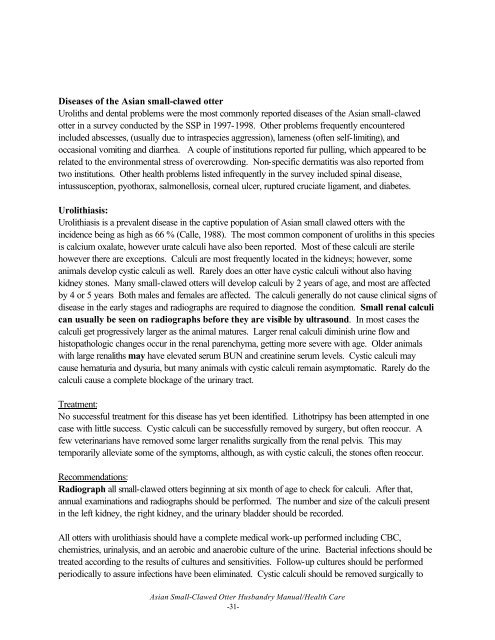Asian Small-Clawed Otter Husbandry Manual (1998)
Asian Small-Clawed Otter Husbandry Manual (1998)
Asian Small-Clawed Otter Husbandry Manual (1998)
Create successful ePaper yourself
Turn your PDF publications into a flip-book with our unique Google optimized e-Paper software.
Diseases of the <strong>Asian</strong> small-clawed otterUroliths and dental problems were the most commonly reported diseases of the <strong>Asian</strong> small-clawedotter in a survey conducted by the SSP in 1997-<strong>1998</strong>. Other problems frequently encounteredincluded abscesses, (usually due to intraspecies aggression), lameness (often self-limiting), andoccasional vomiting and diarrhea. A couple of institutions reported fur pulling, which appeared to berelated to the environmental stress of overcrowding. Non-specific dermatitis was also reported fromtwo institutions. Other health problems listed infrequently in the survey included spinal disease,intussusception, pyothorax, salmonellosis, corneal ulcer, ruptured cruciate ligament, and diabetes.Urolithiasis:Urolithiasis is a prevalent disease in the captive population of <strong>Asian</strong> small clawed otters with theincidence being as high as 66 % (Calle, 1988). The most common component of uroliths in this speciesis calcium oxalate, however urate calculi have also been reported. Most of these calculi are sterilehowever there are exceptions. Calculi are most frequently located in the kidneys; however, someanimals develop cystic calculi as well. Rarely does an otter have cystic calculi without also havingkidney stones. Many small-clawed otters will develop calculi by 2 years of age, and most are affectedby 4 or 5 years Both males and females are affected. The calculi generally do not cause clinical signs ofdisease in the early stages and radiographs are required to diagnose the condition. <strong>Small</strong> renal calculican usually be seen on radiographs before they are visible by ultrasound. In most cases thecalculi get progressively larger as the animal matures. Larger renal calculi diminish urine flow andhistopathologic changes occur in the renal parenchyma, getting more severe with age. Older animalswith large renaliths may have elevated serum BUN and creatinine serum levels. Cystic calculi maycause hematuria and dysuria, but many animals with cystic calculi remain asymptomatic. Rarely do thecalculi cause a complete blockage of the urinary tract.Treatment:No successful treatment for this disease has yet been identified. Lithotripsy has been attempted in onecase with little success. Cystic calculi can be successfully removed by surgery, but often reoccur. Afew veterinarians have removed some larger renaliths surgically from the renal pelvis. This maytemporarily alleviate some of the symptoms, although, as with cystic calculi, the stones often reoccur.Recommendations:Radiograph all small-clawed otters beginning at six month of age to check for calculi. After that,annual examinations and radiographs should be performed. The number and size of the calculi presentin the left kidney, the right kidney, and the urinary bladder should be recorded.All otters with urolithiasis should have a complete medical work-up performed including CBC,chemistries, urinalysis, and an aerobic and anaerobic culture of the urine. Bacterial infections should betreated according to the results of cultures and sensitivities. Follow-up cultures should be performedperiodically to assure infections have been eliminated. Cystic calculi should be removed surgically to<strong>Asian</strong> <strong>Small</strong>-<strong>Clawed</strong> <strong>Otter</strong> <strong>Husbandry</strong> <strong>Manual</strong>/Health Care-31-
















